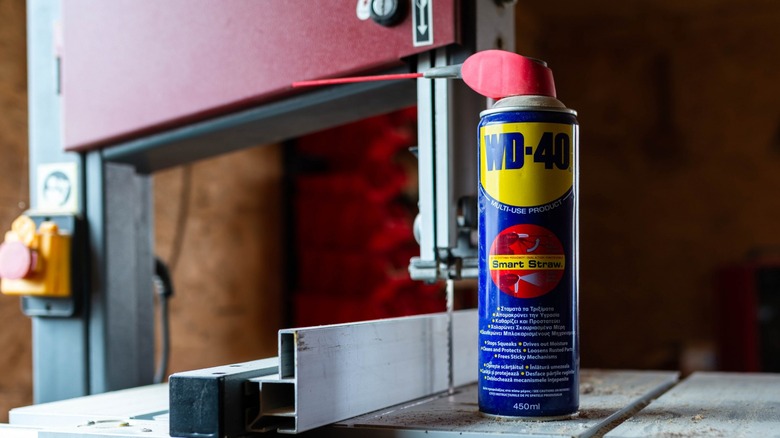How To Use WD-40 To Maintain Your Power Tools
Using WD-40 to maintain your power tools prolongs their life and keeps them ready for service when needed. Since professionals use and clean their power tools regularly, keeping them rust-free is easy. However, most DIYers store their power tools in a cabinet until they're needed to complete a project.
Extended garage cabinet storage subjects power tools to temperature and humidity fluctuations that lead to condensation and rust on metallic surfaces. When left unchecked, the corrosion worsens over time, degrading the lifespan of your power tools.
In addition to its water displacement and rust prevention properties, WD-40 performs as a penetrating oil and a top-notch degreaser. As a penetrating oil, it easily seeps into threaded connections to drive out moisture and prevent corrosion. Its grease-cutting properties aid in keeping your power tools free from sticky sap, cutting oils, and other contaminants. Properly maintained power tools perform as intended, making your DIY projects simpler and safer.
Power tools, like anything mechanical, benefit from routine preventive maintenance. Preventive maintenance can extend the life of expensive power tools, protecting your investment in quality equipment. The following four-step procedure ensures your power tools will perform when needed.
Four steps to properly maintaining power tools
While cleanliness is the first step of proper power tool maintenance, the makers of WD-40 point out that adequate lubrication is equally essential. Use the following procedure to maintain your power tools properly:
-
Remove the power source – It's best to unplug corded tools or remove batteries from cordless power tools before beginning your maintenance routine. Failure to remove the power source could lead to unintentionally activating the device, resulting in personal injury.
-
Remove excess debris – Whether you're using your power tools on wood, plastic, concrete, or metal, removing the resulting dust and chips from power tools using a vacuum, brush, or cloth is essential. While many people like to use compressed air at this step, there are better methods. For instance, consider using a chip brush and a vacuum to remove and contain the mess.
-
Wipe down all tool surfaces – Use a rag or soft bristle brush to wipe down your power tools. When finished, they should be as shiny as they were when you first got them.
Advertisement -
Apply rust prevention and lubrication – Using WD-40 on a rag to do a final wipe down of metallic surfaces helps prevent surface rust. It's also good to spray the lubricant directly into the spindle and drill chuck to displace moisture and lubricate those areas.
How often should I apply WD-40 to my power tools?
While following the steps above before prolonged storage of your power tools is best, cleaning them after every project is also a good idea. In addition, power tools stored unused in a garage cabinet should receive some preventive maintenance at least once or twice per year, depending on the climate.
At a minimum, it's good practice to remove your power tools from their storage space annually to inspect for any damage from rodents or rust. Ideally, stored power tools should receive inspection and lubrication twice yearly, especially if they don't see use for projects during the year.
Power tools stored in a climate-controlled environment fare much better than those in a drafty shed. Since your storage conditions likely exist between those extremes, a maintenance schedule that includes a quick application of WD-40 in anticipation of spring projects and a thorough inspection and lubrication before winter storage (or winter projects) will keep your power tools ready for service when needed.


